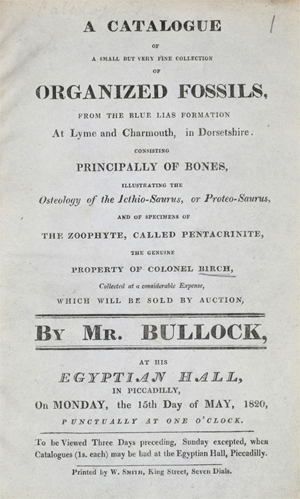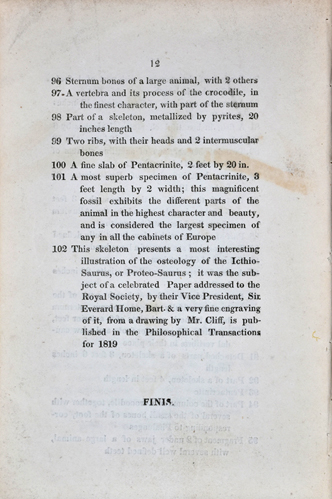Proteosaurus, found 1818

|
Engraving of 'Proteo-saurus', an ichthyosaur from Lyme Regis, by James Basire after drawing by William Clift, 1819. GSL Archive ref: LDGSL/636.
|
This image shows the skeleton of an ichthyosaur which was the most complete ever found at the time of its discovery by Mary Anning in 1818.
Before Darwin’s ideas of evolution were published in November 1859, many scientists such as Everard Home believed in the concept of the ‘Great Chain of Being’ as an explanation for the sheer variety of Earth’s creatures. From the simplest to the most complex, the Great Chain of Being placed every animated lifeform into its own rung in a graduated, hierarchical structure that demonstrated the perfection of Divine creation. Identifying where these creatures would fit was achieved by comparing the anatomy of modern species and finding those which they most closely resembled.
In Home’s previous papers, he had been reluctant to suggest where in the Great Chain of Being the new creature might belong. This new specimen, however, at last gave him enough data to try. He thought the convex forms of the vertebrae and its apparent feet appeared similar to a salamander (genus=proteus), but the method of breathing which he derived from the shape of the ribs and sternum were reminiscent of a lizard (Greek= sauros). Home confidently asserted:

|
| Source:Wellcome Trust |
“Its place in the chain of animal creation is clearly pointed out to be between the proteus and lizard, and will be sufficiently marked out by calling it Proteo-saurus." From E Home, "An account of the fossil skeleton of the Proteosaurus", Philosophical Transactions of the Royal Society, vol 109, (1819).
Home’s name of
Proteosaurus never stuck because in 1817 Charles König (1774-1851), keeper of natural history at the British Museum, coined the name
‘Ichthyo-saurus’ indicating his belief of the creature’s place in the Great Chain of Being as an intermediate between fishes and lizards.
Again Home does not cite Anning as finder of the specimen. Like before only its owner, Lt Col Thomas Birch (c.1768-1829, GSL membership no.612) is named. Birch almost certainly acquired it from the Annings along with a number of the prime specimens in his collection. When in 1819 he discovered that the Anning family were about to have to sell their furniture to pay their rent, he organized the sale of his fossil collection in their aid. It raised over £400.

|
|
 |
Catalogue of the sale of Thomas Birch’s collection which was sold in aid of Mary Anning and her family at William Bullock’s Egyptian Hall, 15 May 1820. GSL Library collections.
The ichthyosaur specimen (lot no.102) was purchased by the Royal College of Surgeons (where Home was curator) for the sum of £100. It was destroyed during a World War Two air raid in May 1941.
|
<<Back
Next: Reconstruction of Life >>